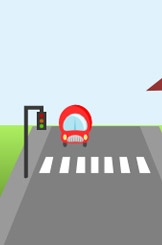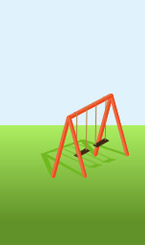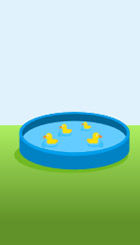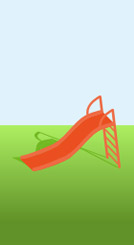Child Farm Safety

Click here to download this trend report on agricultural injury and fatality, produced by Farmsafe Australia with funding from the Australian Government’s National Farm Safety Education Fund. The Snapshot page is shown below, if you scroll down.
It is a concise and very informative booklet with snapshots of 2021 injuries and fatalities numbers, along with some great articles as follows:
- Snapshot - Celebrating improvements made – every step that we take towards zero needs to be counted.
- Snapshop - 2021 statistics
- Recipe for Averting Disaster - issues featuring in Farmsafe campaigns and during National Farm Safety Week.
- Building a Safer Farms, Safer Farmers Culture - The Importance of Inductions
- The Blurred Line Between the Work & Home Environment - Child Safety on Farms
- Increasing Our Well-being - Investing in Physical and Psychological Well-being.
- The Case for The Card - pursuit of the development of an\ farmer accreditation system like the ‘White Card’ (in construction).
- THE EVIDENCE - Quad Bike Rebate Report
- UPDATE - National Farm Safety Education Fund Strategy
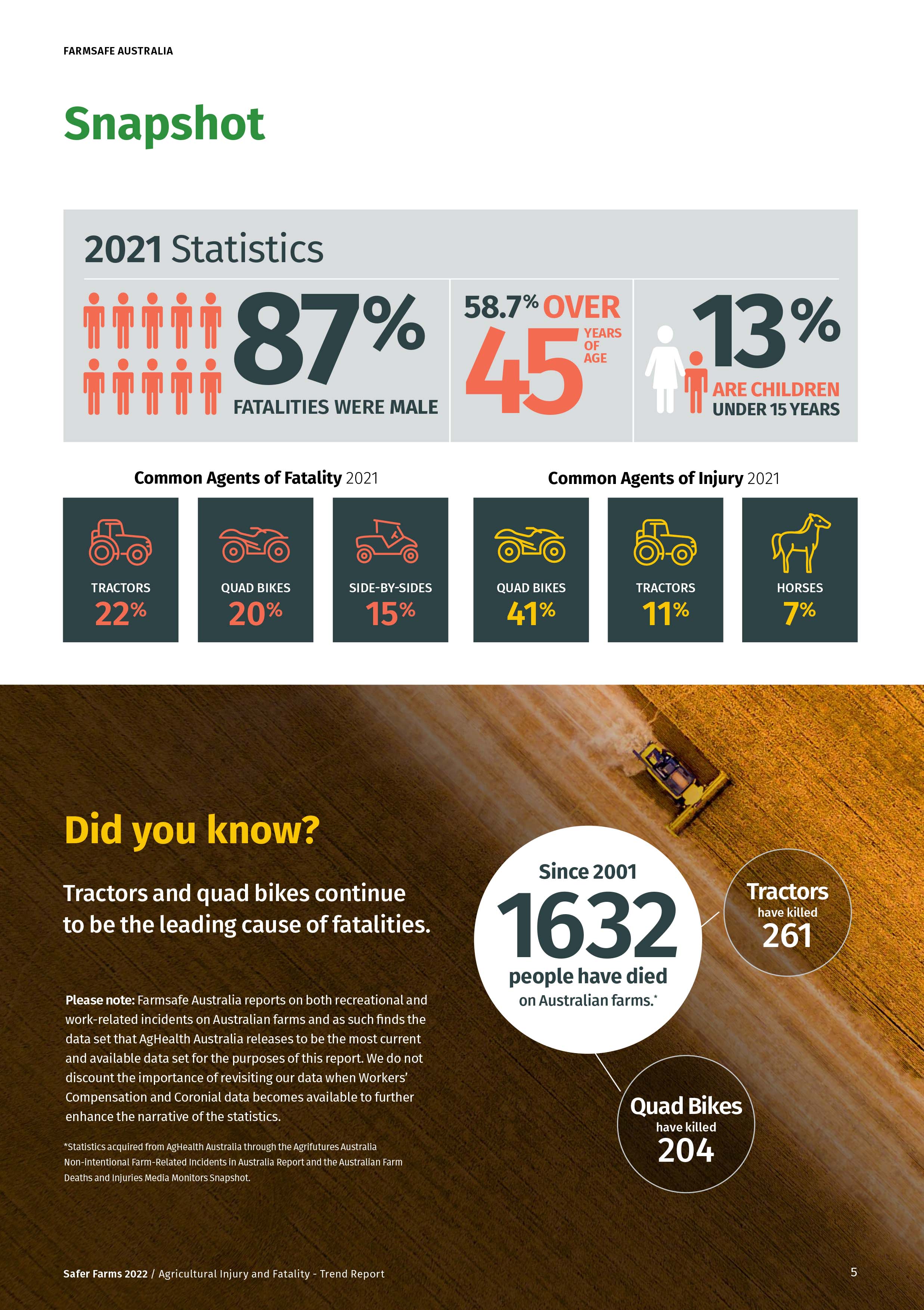
This project is supported by the Department of Agriculture, Fisheries and Forestry (DAFF), through funding from the Australian Government’s National Farm Safety Education Fund.
A Parent’s Guide to Kidsafe Farms - 32 page booklet
A farm provides a happy and healthy environment in which to raise your family. However, a farm
can also be a dangerous place for children.
Australian farms remain a high risk setting for injury and fatalities. As a farm is also a workplace,
the number of potential hazards can be greater than that found in a typical home.
This booklet gives great information on keeping children safe on farms. Click here to download the booklet.
National Farm Safety Week 2021 - high rates of unintentional injury and death in children on farms
The theme of this year's Farm Safety Week is week is ‘Farm Safety Through The Ages – From 2-92’.
Here is a link to an article by ABC News Vic Country Hour journalist Jane McNaughton, that really highlights the safety issues for children on farms. Click here to see the article.
Some key points of concern:
- Approximately 15 children are killed on Australian farms each year
- Almost one in six farm fatalities are kids.
- 15 per cent of farm deaths are children under 14 years old, according to an AgHealth Australia study
- Children have higher rates of unintentional injury and death than children in metropolitan areas.
- Dams and large bodies of water pose a drowning hazard for children.
- Quad bikes are really dangerous - many Australian children have die in quad bike accidents in recent years
Also motorbikes and farm vehicles, such as tractors, as well as farm animals
All of these risks can me minimised or eliminated by proper supervision and farming practices that take into account childrens' presence on the farm. More detail of strategies such as safe play areas, are shown below. Click here for a datasheet on farm safety.

Kidsafe Tasmania's Farm Safety Tips
- Active adult supervision is essential to prevent childhood injuries on farms. It’s a good idea to have set supervisors so there is no confusion about who is watching the children.
- Create a safe play area that is securely fenced, visible from the house and has a range of interesting and challenging activities for children, to help prevent unsupervised access to hazards such as dams, animals and machinery.
- Educate children from a young age about potential hazards and set clear farm safety rules and guidelines.
- Have age appropriate jobs for children and restrict their involvement in dangerous tasks.
- Ensure children always buckled up appropriately for their size and age when travelling in vehicles on the farm. Don’t allow children to ride in trailers or in the back of utes.
- Kidsafe does not recommend that children under 16 years old ride or be a passenger on a quad bike.
- Ensure all poisons are kept in their original containers and stored away in a locked area out of the sight and reach of children.
- All families and farm workers should know correct first aid procedures to ensure they are prepared in the event of an emergency.
Health and safety problems associated with children on farms
The majority of Australian farms are family owned and operated enterprises. Children on farms can have an enriching life, yet can also be exposed to a variety of workplace hazards not present at most homes. Children are seriously injured on Australian farms and rural properties each year.
- There is about one farm related child death in Australia every 10 days (Pollock et al, 2007).There are more than 10 children admitted to hospitals with farm related injuries each week (Kreisfeld, 2007).
- There are more than 10 children admitted to hospitals with farm related injuries each week (Kreisfeld, 2007).
- Many more children with farm related injuries also present at Emergency Departments of country hospitals and to General Practitioners (Franklin & Crosby 2005).
Key problem areas identified through the research are:
Drowning (0-5 years)
- Injury associated with 2 and 4 wheeled motorcycles (5-15 years)
- Injury associated with other farm vehicles
- Horse-related injury (5-15 years)
- Injury associated with farm machinery
Other hazards/causes of injury on farms include silos, chemicals, noise and firearms.
However, injuries from these do not appear prominently in injury statistics.
- One prominent study of fatalities on farms found that one third of child fatalities were visitors to the farm.
- Boys were killed more often than girls (3:1) and three-quarters of children were playing at the time in an area where farm work was being carried out (Franklin et al, 2000).
- Younger children are at greater risk, with two thirds of child fatalities on farms being under five years of age.
- Older children 5-15 years presented to emergency departments with non-fatal injury more often than younger children, perhaps reflecting more leisure activities with horses and motorbikes and their expanding work roles.
Safe Play Areas
A safe play area, such as a securely fenced house yard, helps to prevent unsupervised access of children to farm hazards.
- It defines the boundary between the “home” and the “workplace” - where dangers exist that aren’t present in the home and stops a child from easily crossing that boundary.
- It can also help stop farm hazards from getting near the children (eg horses, cattle).
- The design is critical. A high quality fence for a small area is better than a lower quality fence for a larger area.
- Don’t assume your child resistant fence is 100% effective 100% of the time – plan for the unexpected. A fenced house yard/safe play area should be supported with active adult supervision and family rules and it is always useful to have resuscitation skills.
Drownings
- Farm dams are the biggest single cause of child injury/death on Australian farms, accounting for 36% of all child farm injury deaths. 75% of the children who drowned lived on the farm (Pollock et al, 2007).
- Drowning in dams was five times more common than in swimming pools on farms.
- Ways of preventing drownings on farms
- Create a safe play area for children
- Securely fence swimming pools, effluent ponds, channels and dams near the house.
- Fit tanks, wells and troughs near the house with lids/mesh.
- Fill in unused dips and ditches.
- Make sure there is close and active adult supervision at all times.
- Develop family rules for when outside the Safe Play Area such as avoiding dams until children are older and holding hands within easy reach of an adult when close to a dam.
- Dress children in brightly coloured clothing.
- Learn and practice resuscitation and emergency procedures.
Quad Bikes & Motor Bikes
- Quad bikes are the second leading cause of death to children under 15 years behind drowning (Pollock et al, 2007).
- Over 32% of all injuries to children 0-19 years requiring hospitalization in Australia are associated with motorbikes (Kreisfeld, 2007). Two wheel motorbikes and older children are more frequently involved in these injuries.
- Quad bikes, although involved in fewer injuries, generally result in more serious injuries such as head injuries and crushing of the trunk and chest.
Ways of preventing accidents and injuries:
- Children under 16 years should never ride quad bikes.
- Children should only ride motorcycles that are appropriate for their age and size ie.
- Adjust the throttle of a child’s motorcycle to limit maximum speed.
- Construct controlled riding areas / tracks for children to learn to ride motorcycles.
- Training and supervision
- Children should never be carried as passengers on quad bikes.
- Personal protective equipment
- Children should always wear a helmet and boots when riding a motorcycle.
Other Significant Farm Hazards
- Children are killed and injured when riding unrestrained as passengers in vehicles, in the back of utes or run over by vehicles.
- Horse related injuries - children who ride horses need traing in riding, approaching, tending from the ground (grooming etc).Horses should be suited to their age, size and riding ability, Suitable helmets & boots.
- Children are at risk of being run over by farm machinery or injured as passengers.
- Other hazards on the farm include firearms, chemicals, electricity, noise and silos.



